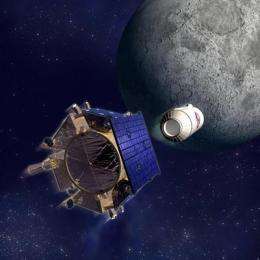Hubble observes LCROSS impact: Preliminary analysis shows no clear evidence for hydroxyl

(PhysOrg.com) -- NASA's Hubble Space Telescope has made a series of observations immediately preceding and following the Lunar Crater Observation and Sensing Satellite (LCROSS) Centaur rocket stage and shepherding spacecraft impacts at the lunar south pole, on October 9 at 7:31 and 7:35 a.m. EDT.
Hubble's Wide Field Camera 3 (WFC3) and Space Telescope Imaging Spectrograph (STIS) were pointed just off the southern limb of the moon to look for a cloud of vaporized material blasted into space by the successive impacts of the rocket booster and spacecraft. The WFC3 images do not show any evidence for a temporary exosphere resulting from the impacts.
Hubble's ultraviolet sensitivity allowed astronomers to look specifically for hydroxyl (OH) that would have been produced by vaporized material from the impact. The STIS and WFC3 looked for emission from OH which would have formed if water molecules had been thrown into sunlight and broken apart by ultraviolet radiation into hydrogen and hydroxyl.
"A preliminary analysis of the STIS spectra do not show any clear evidence for hydroxyl, but further analysis is needed," said Hubble co-investigator Alex Storrs. The Hubble team plans on further analysis of their data.
Provided by European Space Agency (news : web)


















